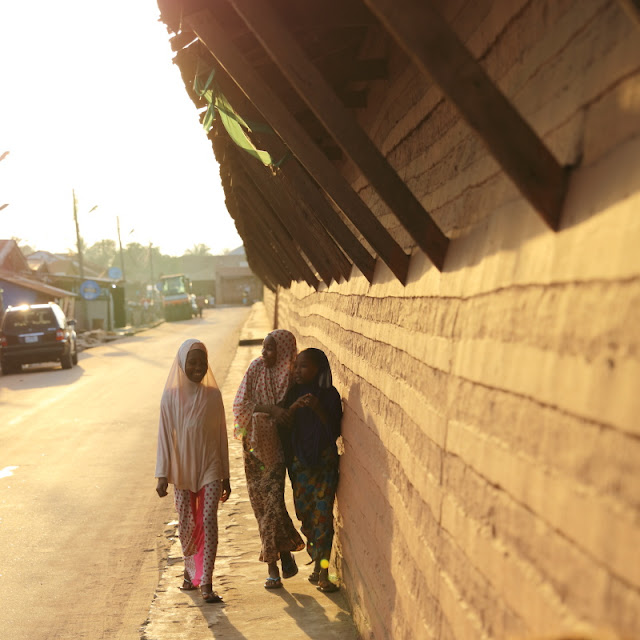 |
| Benin City's popular fashion |
Traces of the past are very present, for instance the Oba's palace is still surrounded by a large mud wall. The city has sprawled in all directions. Trading buildings, administration buildings are among the tallest, most of them worn out by time, dusty winters and strong rainy seasons. Large avenues are running through the city, but as soon as one leave them to adjacent roads, potholes and dirt roads slow down navigation. Easier for motorbikes. Market areas are usually buzzing with people and go-slows. It seems to me that drivers are more daring and opinionated that in Lagos. It is somewhat natural to drive against the traffic and act as if vehicles in the opposite direction should make way. People like it colourful, from the way people dress to the decoration of buildings. It is an exuberance of colors and shapes to protest against an otherwise dusty city? On the education front, the University of Benin (Uniben) has a good reputation in the country.
 |
| when taxis share colours with watermelons |
Records of the Benin Kingdom date back to around 900 AD at the beginning of the Ogiso dynasty with the Ogiso Igodo. The Ogisos reigned for 300 years over a land that was called Igodomigodo. Towards the end of the 12th century, a dispute came up at the royal court which resulted in the exile of Prince Ekaladerhan who later became Izoduwa or Oduduwa the first Ooni in Uhe (Ile Ife in today's Yorubaland). Oranmiyan or Orunmillan (Yoruba name), grand son of Oduduwa took up his abode in the palace build for him at Usama by the elders. He married a beautiful lady, Erinmwinde, daughter of Osa-nego who was the ninth Enogie (Duke) of Ego, by whom Oranmiyan had a son. After some years residence there, he called a meeting of the people and renounced his office, remarking that the country was a land of vexation and that only a child born, trained and educated in the arts and mysteries of the land could reign over the people. He called his son, born to him by Erinmwinde, to be made King in his place and returned to Yorarubaland Ile-Ife. After some years in Ife, he left for Oyo and also had a son there called Ajaka who ultimately became the first Alaafin of Oyo of the present line, while Oranmiyan himself was reigning as Ooni of Ife. Oranmiyan's son fought the Kingdom of Benin and eventually became Eweka I, the first Oba of Benin who reinstated the principle of primogeniture in the succession of Obas.
This shows how close ties were between Yorubaland and the Benin Kingdom which played a very influential role in the region (eastward over Igboland and westward over Yorubaland as far as Lagos and beyond) which is noticeable through similarities in languages and religious practices of Igbos and Niger delta, but also through administration. The Kingdom also played an important part in trading relations with Europeans from the 15th century onwards. After that period, the land of the Kingdom was referred to as Edo.
For the first time in the 1480s, the Benin Kingdom was in touch with Portuguese traders, who started trading ivory, pepper and palm oil against manila and weapons. Benin sent an embassy to Portugal and Portuguese established a catholic mission in Benin City.
 |
| the mud wall of the Oba's palace |
Initially, the Oba did not allow for trade of slaves, except for few women and children from other tribes, as they needed men to wage their imperial campaigns over neighbouring lands. Slaves only started in the 18th century as the Kingdom's finances became more strained. Before that, Europeans would buy, besides pepper, some cotton cloths, cowries and beads which could be traded for slaves in other ports of the West African coasts. The Kingdom of Benin was as well an entry point for trade between Europeans and neighbouring tribes such as the Ijebus and the Itsekiris through their ports of Ughoton and Arbo.
In the 19th century, the British were willing to exert more influence in their relationship with Benin, they pushed the enforcement of the abolition of slave trade and started to nurture colonial ambitions. They were militarily stronger thanks to all sorts of new weapons.
In 1897, under the pretence of opposing Benin's traditional practices such as human sacrifice, the British set-up an expedition to crush the resistance of the Kingdom, the British looted the city of Benin and sent home a large collection of bronze artifacts, some of which are on display in the British Museum.
After that, the Kingdom never recovered.
 |
| refreshingly different was Benin City |
source: wikipedia, Institute for Benin Studies
Comments
Post a Comment